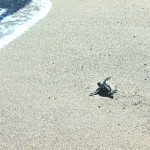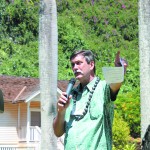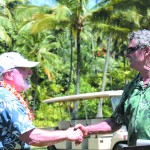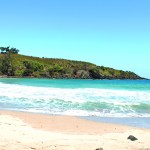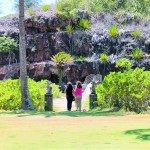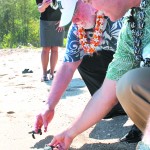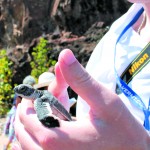Protecting Lawai Kai
Thanks to the work of Kaua’i citizens and the signature of the governor, a pristine beach will remain that way for generations to come
Waves lapped lazily on the Lawai Kai shoreline as members of the community watched Gov. Neil Abercrombie release a tiny baby green sea turtle into the ocean. The ceremony was hosted by the National Tropical Botanical Garden in commemoration of Lawai Kai Advisory Group’s recent successful efforts to protect the South Shore area – a place where turtles still are afforded a safe sanctuary on the island – in perpetuity.
- From left, members of the Lawai Kai Advisory Group: David Chang, Beryl Blaich, Rick Haviland, Hartwell Blake and Tessie Kinnaman
- A baby sea turtle powers toward its first dip into the sea
- Chipper Wichman, director of the National Tropical Botanical Garden
- Gov. Neil Abercrombie and biologist Don Heacock shake hands at the Lawai Kai ceremony
- Lawai Kai
- Lawai Kai recently was established as a special zone
- Gov. Neil Abercrombie and NTBG director Chipper Wichman release baby green sea turtles into the ocean at Lawai Kai
- The protection of Lawai Kai will help the survival of species such as the endangered Hawaiian green sea turtle
- Kaua’i jammer Tamminator T2 passes Waimea’s Sadie Mae Gutz and Dyna Mike for points
“This place is one of the very few remaining areas that we can leave for the future children to come to,” says Saburo Yoshioka, a member of the advisory team.
The Kaua’i native also is a member of the Kukuiolono Association in Kalaheo, and in 2007 was asked to join a newly formed group.
“I thought that if we can preserve a part of Kaua’i for the future, I want to be a part of that,” he adds.
Having seen a large portion of the island damaged from overuse through the years, Yoshioka is relieved that Abercrombie recently signed into law the Lawai Kai Special Subzone, an amendment to Rule 13-5 of Hawaii Administrative Rules, that will protect the lower Lawai Valley (NTBG’s Allerton Garden), the adjacent beach and Lawai Bay.
“I take great pride in it,” says Abercrombie. “We have a sacred duty to not just recall or remember, but to provide a living instance in which the treasure and the legacy of Hawaii is brought forward for us to understand what we need to do today to protect it in the future and give us a sense of direction.”
The governor commends volunteers like Yoshioka in the community who come from all walks of life – including families historically connected to the area, who dedicated so much of their time to the cause. Advisory members spent years studying other protected areas across the state, researching Lawai Kai’s history, archaeology and biology, developing a 20-year master and management plan for future preservation of the area and ultimately applying for the special subzone designation.
“You cannot come to this pu’uhonua (place of refuge) without being deeply affected,” says Abercrombie.
The goal is to manage the land while maintaining its delicate resources for the purposes of conservation, education and recreation.
“We don’t want it to look like Kee Beach,” says Kaua’i County Councilwoman Nadine Nakamura, a member of the advisory group. “Lawai Kai is such a special place. We can see what happens when we don’t take care of our resources.”
The place is not only of environmental significance, but it also is historically rich in culture with burial grounds, a heiau and Queen Emma’s cottage. Keeping the beach relatively secluded and restricted from easy access is the key to preserving its unscathed natural bounty.
Public-access advocate and member of the advisory committee Beryl Blaich had a hard time grappling with this issue, but as the coordinator of Malama Mahaulepu, she knows that without management and control, distinctive places like Lawai Kai are no longer exclusive treasures to behold.
“It doesn’t mean we can’t still enjoy it. It just means it isn’t going to be a fun experience to get there,” jokes Tessie Kinnaman, a member of the advisory committee who is glad that her childhood refuge will remain protected.
Generations of Islanders like Kinnaman have enjoyed Lawai Kai for centuries. Hawaiians were known to have utilized the space for hundreds of years. After 1848, the land was awarded to James Young Kanehoa and later his wife Hikoni. The plot was then deeded to Queen Emma (Kanehoa’s niece), widow of Kamehameha IV. For a number of years, the land was leased and later purchased by the McBryde family. In 1938, Robert and John Allerton purchased the lower portion of the valley and spent a number of years creating the 90-acre landscaped gardens that eventually were left in a trust and are now managed by the nonprofit NTBG.
“This has been a long time coming,” says Chipper Wichman, director of NTBG, who first started discussing the idea of Lawai Kai’s preservation in 1992 following Hurricane Iniki.
With the South Shore continuing to expand and grow, pressure has increased on the valley, so it especially needs this attention. And because of NTBG’s preservation efforts, an abundance of turtles have nested comfortably there this year. Wichman hopes that, with the new law, this activity will persist.
But there is still much to be done, and management endeavors are next on the to-do list, with options being discussed, such as having docents regularly patrol the beach.
“Koloa is a beautiful place and it deserves to be preserved,” says advisory member Hartwell Blake.


